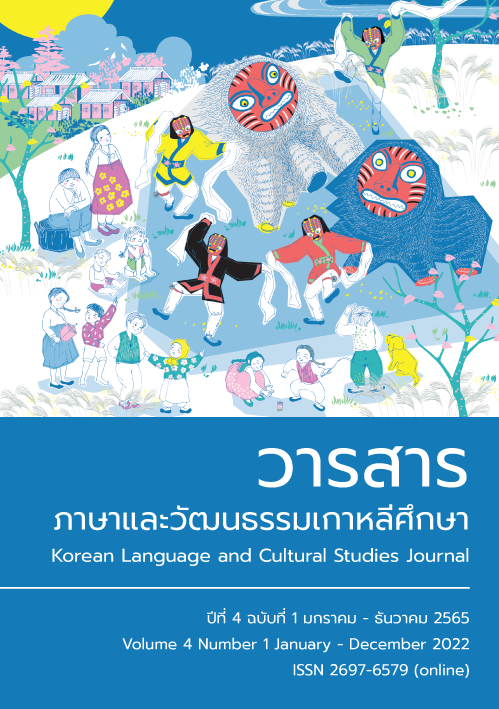The Analysis of the Case Marker in Korean Resultative Construction for Thai Learners
Main Article Content
Abstract
This study aims to analyze the syntactic of Korean resultative construction (RC) and the case marker used in its components. Korean RC are determined by using suffix ‘-ke’ between the main clause and matrix clause. Most of Thai leaners do not understand the case marker used in each main clause and matrix clause in RC, directly leading a set of linguistic errors. To minimize these errors, it is necessary to analyze the argument structure in each clause to use case marker suitable. In order to analyze Thai learners’ understanding of the usage of case marker in RC, an online survey was conducted on 30 Thai students who learned the ‘NP1 NP2 AP VP’ construction which is intermediate Korean language skill.
After reviewing the survey results, it can be clearly seen that mostly the construction which Thai Learners do not understand was clausal resultative construction. When Thai learners learn about Korean RC, it can be seen that the RC may be considerable confusion due to the grammatical characteristics that are different from other constructions. In order to provide the correct and efficient education, the chapter 4 of this study analyzed the linguistic errors by using generative grammar to show how case markers are generated. First of all, the phrasal-resultative construction can be used the transitive verb (TV) and intransitive verb (ITV) in the main clause. In case of clausal-resultative construction, it is not only determined by TV and ITV, but also determined by the component that the matrix clause described. It can be divided into three categories: subject description, object description and subject and object description. In conclusion, the study will pave the avenue for Thai learners to accurately apply the syntax of RC and the usage of case marker in RC, so Thai learners can use Korean more smoothly and accurately.
Article Details
References
김기혁. (2009). 사동구성의 긴밀성과 피사동자 격표시. 한글, 283, 93-126.
김성욱. (2015). 영어 결과문에 관한 소고. 영어영문학연구, 57(1), 109-129.
김영희. (1992). ‘-게 하-’ 사동 구문의 세 유형. 국어학, 54, 89-120.
남기심⦁고영근. (2019). 표준 국어문법론 (전면개정판), 한국문화사.
박소영. (2004). 한국어 동사구 수식 부사와 사건구조. 서울: 태학사.
박철우. (2014). 한국어에는 주어가 없는가, 현대 문법연구, 76, 149-172.
송홍규. (2007). 국어 결과 구문의 구성에 대하여. 민족문화연구, 46, 191-225.
심지영. (2015). 한국어 결과 구문으로서의 ‘V1어 V2’ 특성 고찰. 새국어교육, 103, 356-390.
엄홍준. (2017). 한국어에서의 장형 사동 구문에 대한 통사 구조. 현대문법학회, 92,107-122.
오충연. (2010). 국어 결과 구문의 범주 설정에 대한 연구. 언어연구, 26(3), 595-619.
와시오 류이치. (1997). 결과표현의 유형. 어학연구, 33(3), 435-462.
이숙. (2007). ‘-게’ 결과구문에 대한 연구. 한국어학, 34, 233-256.
이홍식. (2020). 이중주어 구문의 의미역에 관하여. 비교문화연구, 59, 293-326.
임동훈. (1997). 이중 주어문의 통사 구조. 서울대학교 규장각한국학연구원, 19, 31-66.
홍기선. (2011). 영어의 결과 구문과 한국어의 “-게” 구문. 한국언어학회, 36(4), 1143-1169.
황주원. (2011). 한국어 결과 구문의 의미 특성. 한국어 의미학, 36, 531-556.
Chomsky, Noam. (1981). Lectures on Government and Binding. Dordrecht: Foris.
Levin, Beth, & Malka Rappaport Hovav. (1995). Unaccusativity At the Syntactic- Lexical Semantic Interface, Cambridge: MIT Press.
Li, Y. (1999). Cross-componential causativity. Natural Language and Linguistic Theory, 17, 445-497.
Sriprasit Mingmit. (2003). A diachronic study of /laeaew/, /yuu/ and /yuulaeaew/. M.A Dissertation. Chulalongkorn University.
Wechsler, S. & Noh, B. (2001). On resultative predicates and clauses: Parallels between Korean and English. Language Sciences, 23(4-5), 391-423.
Yeo, S. (2006). Some Notes on Resultatives in Korean, Studies in Generative Grammar, 16, 687-706.


